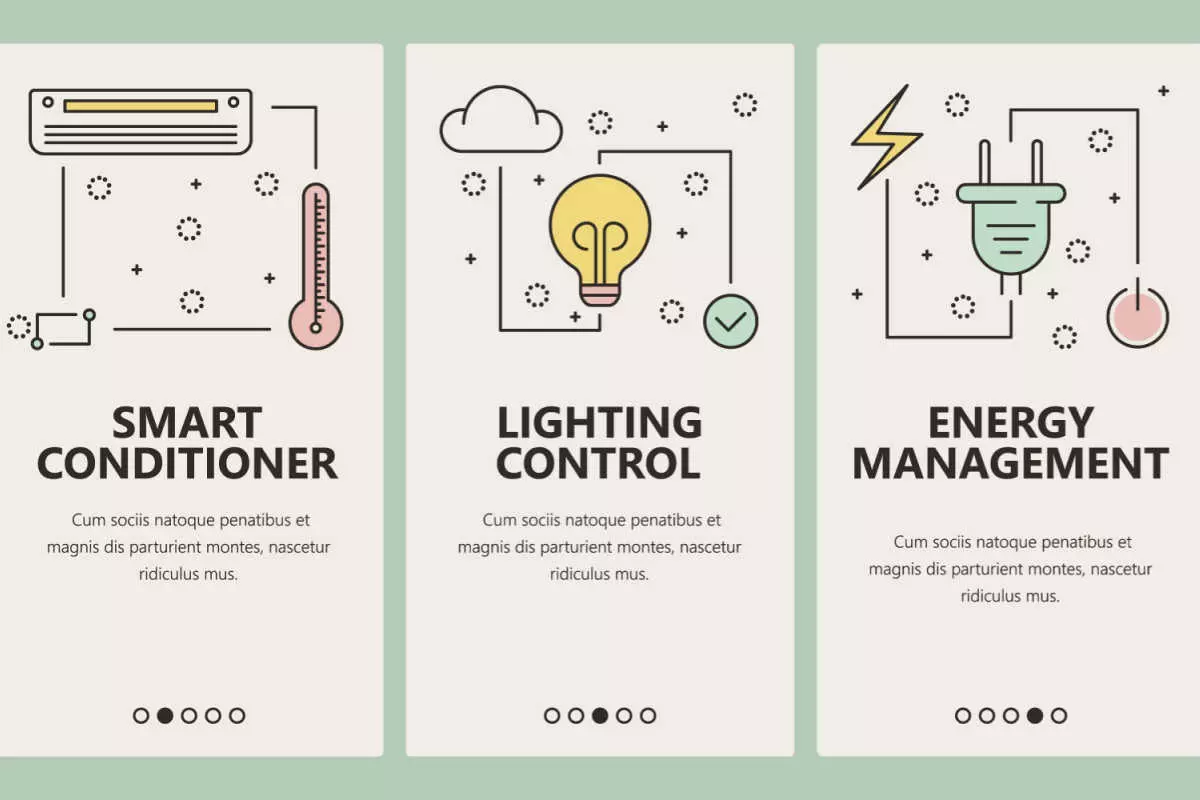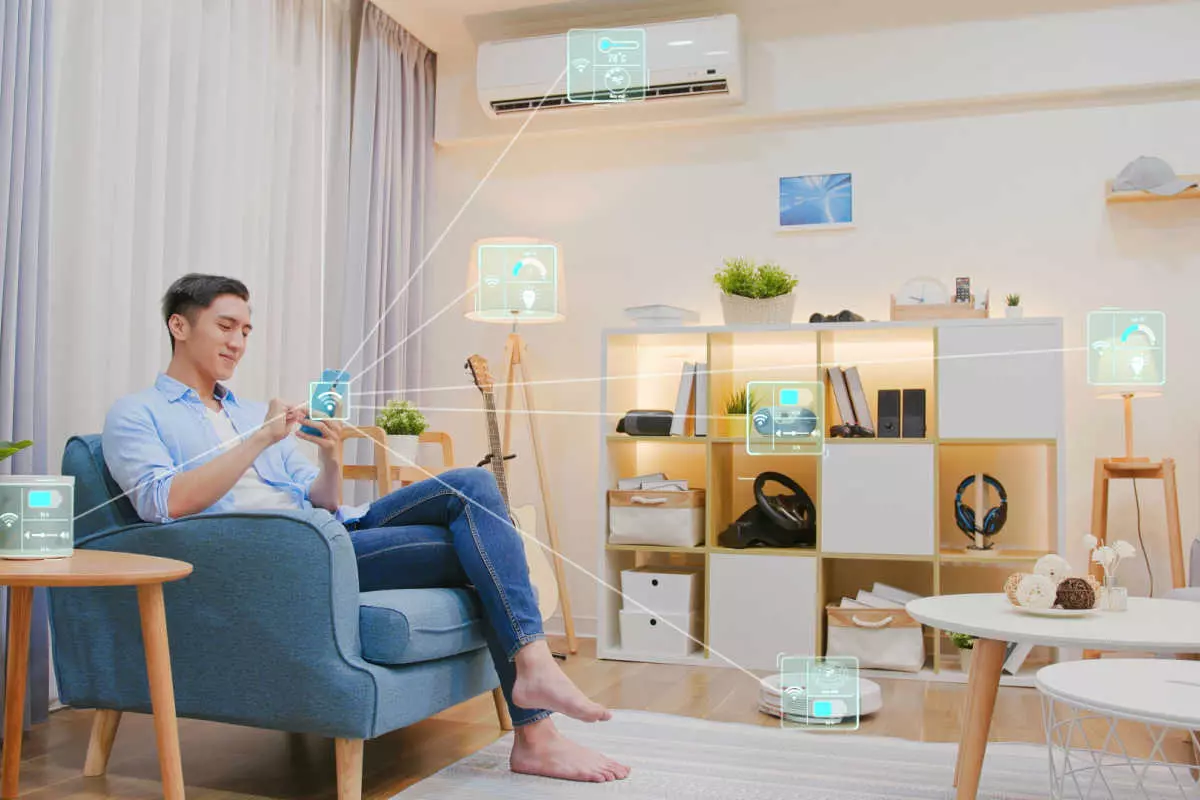AI and Home Automation: How Emerging Technologies are Making Our Homes Smarter
In recent years, artificial intelligence in home automation has entirely transformed how we interact with our homes. For example, you can now walk into your house and tell your virtual assistant to turn on the lights, command the coffee to start making itself and control the temperature in the room.
There’s no point in denying that AI-powered home automation has made our homes more comfortable, efficient, and secure. In this blog, we will explore how AI is revolutionizing our homes and how you can benefit from it. From the best home automation software to smart appliances for your home, we break down all you need to know below.
Smart House Systems and Home Automation
Smart house systems and home automation are closely related concepts. Often used interchangeably, they refer to the usage of AI to automate and control different systems and devices in a home.
What is a Smart House System?
A smart house system is a comprehensive system that integrates various technologies, including lighting, heating, and security systems. The homeowner can enjoy a seamless and AI-driven experience by controlling functions from either a smartphone or an audio speaker.

Home automation refers more specifically to using technology to control different functions within a home. For instance, it includes the processes of scheduling timers for lights, changing thermostat settings, or monitoring security systems from a mobile device.
Both smart house systems and home automation rely on wireless technology to perform various tasks and functions. In essence, smart house systems are the general concept of a centralized control hub that sends signals to different devices. On the other hand, home automation can refer to simpler, more individualized devices that may not require a central hub, such as Amazon Alexa or Google Assistant.
Smart Home Electronics
Investing in a home automation system and smart home technology means enjoying a hi-tech and secure living environment in your house. From the garage to the kitchen, the following devices are designed to make our lives easier and more streamlined:
Outdoor Devices
From a diverse selection of the best smart home devices for the backyard, here are some that stand out:
Pool Water Monitors
These smart home devices allow you to test the water in your pool via a smartphone app. The system can evaluate the amount of water or chlorine and tells you the optimal amount to have in your backyard pool. The WaterGuru Sense is a popular monitoring device that connects to the pool’s water skimmer and helps you regulate the water regularly.
Lawn Mowers
Mowing the lawn can be an exhausting activity for many people. Smart outdoor mowers like Worx Landroid S map out the entire yard and cut the grass according to a set schedule, all while controlled through a smartphone app. It also takes weather forecasts into account while setting a custom schedule.
Outdoor Security Cameras
Popular cameras like Arlo Pro 4 Spotlight Camera can monitor your outdoor area through AI. These cameras offer full-night vision and video recording that send alerts when triggered by motion or spotlight.
Living Room Area
Equipping your living room with smart home technology optimizes your daily activities and offers you comfort. Here are some devices you can add to your interior:
Smart TVs
Smart TVs are becoming an integral part of each household. Today, you can access television, your favorite music streaming services, and video-on-demand (VOD) platforms with integrated Bluetooth technology and Wi-Fi.
Voice Control Lighting
You can get complete control over the lights in your home by synching smart bulbs and smart lamps with Alexa or Google Assistant. You can ask the smart home assistant to dim or change them to your preferred color and intensity.
Smart Ceiling Fans
These incredibly futuristic devices are pretty affordable and accessible, such as the Haiku Home L Series 52’’ smart ceiling fan. Connecting a Bluetooth speaker to the device lets you cool your room or hide the retractable blades when you don’t need them from an app.
Robot Vacuums
These devices have become one of the most popular AI robots in recent years. Robot vacuums can be programmed to clean all types of floors and rugs with more intensity where it’s dirtier. Some models, like the Roborock E20, can even be controlled with voice commands for scheduling cleaning sessions at particular times.
Smart Kitchen Appliances
Smart kitchen devices provide a seamless cooking experience and do some of your chores for you. Here are some devices to keep an eye on:
Smart Refrigerators
When connected to Alexa or an app, you can monitor the temperature of your refrigerator and freezer and adjust the water filter’s status. The AI-driven technology can also alert you if you’ve left the fridge door open or in case of a system malfunction.
Smart Ovens
With just one click on your phone, you can preheat your oven from anywhere inside and outside the house. You can also monitor the cooking time and check how much time is left on the timer when you’re not in the kitchen.
Smart Dishwashers
Like a smart fridge and oven, a smart dishwasher can also send notifications to your phone when it’s time to refill it with more pods or to rinse. You can also view the status of your dishwashing cycle even when you’re not home.
Miscellaneous Devices
In addition to common home appliances, here are some other devices that can make your life easier and home more comfortable:
Baby Monitors
These are devices that allow parents to keep an eye on their children while they sleep or play. Modern AI-powered baby monitors include video cameras that can be accessed through smartphone apps. They also have motion sensors and sound alarms to alert parents when their child wakes up or starts moving around.
Pet Feeders
These devices allow pet owners to program automatic feeding schedules for their furry friends. They also have smart cameras and microphones, enabling pet owners to check in on their pets and interact with them remotely.
Smart Plugs
Smart plugs are devices that can be plugged into standard outlets and allow you to control the power supply to the connected appliances through an app or voice control. For instance, you can command an outlet charging your phone to cut the power once it hits 100%.

Best Home Automation Systems
When choosing a home automation system, you must first check if it’s based on open protocols. This means the system is not owned by any particular company and is not limited to one company’s products. Open protocols allow for inter-compatibility between different devices from different manufacturers and ensure greater security, protecting your home from unauthorized access.
Apart from that, the best home automation systems include multiple useful features, such as air conditioning, heating, window blinds, and so on. Below are some examples of different home automation software you can trust when you’re in town or away on vacation:
Home Assistant
Home Assistant is a free, open-source platform that allows you to control a wide variety of devices and services in your home, including lights, TVs, computers, and telephones. As Home Assistant is based on open-source software, you can modify its source code freely to customize features and integrations to enhance the system’s functionality. For instance, you can add a custom weather sensor that provides more detailed weather information.
This home automation system offers a vast range of features, some of which include:
- Representational State Transfer API (REST API) integration with a large number of devices and platforms, including Google Home, Amazon Alexa, Philips Hue, Nest, and more.
- Customization via various themes, integrations, and add-ons (e.g., car tracking and weather monitoring)
- Easy installation and configuration through a user-friendly web-based interface.
- Control over locks, lighting, home security systems, temperature, etc.
Home Assistant is completely free to use. However, you will need to purchase any hardware or devices that you want to use with the system. And while Home Assistant is a powerful and flexible home automation system, it can be complex to use and may require technical knowledge to set up and configure.
Apple HomeKit
Apple’s home automation platform allows you to control through Siri or the Apple Home app. Through the Home app or Siri, you can unlock the front door, dim the lights, or play music on speakers. Apple HomeKit works only with iOS devices and does not support third-party operating systems like Android or PC.
When setting up devices, you need to scan a QR code to add them to the app. Then, you can organize each HomeKit device into different areas in your home. Once done, you can command Siri to switch off the lights in the kitchen or increase the temperature in the bedroom.
The main device you will need is an Apple HomePod mini, which costs $100, or an Apple HomePod 1st or 2nd generation, costing from $300 to $450.
It can pick up incoming calls from your iPhone, put on your favorite shows on Apple TV, or play your favorite song on your Mac. However, the main drawback of Apple HomeKit is the limited range of compatible devices compared to other smart home ecosystems.
Amazon Alexa
We have all heard catchphrases with Alexa in daily conversations, commercials, and movies. Amazon’s virtual assistant has made a significant impact due to its ability to switch on or off lights, play music, or even act as your opponent for games.
Alexa is a favorite in many smart homes because it can provide practical suggestions in various situations. For example, it can suggest new music based on your previous listens or reminds you of tasks you plan to complete later.
Among its many features, here are some that stand out:
- Availability on various devices, including Echo speakers and Fire TV devices.
- Ability to make and receive voice calls and messages.
- Ability to play music and podcasts, as well as tune into radio stations from Apple Music, Spotify, Amazon Music, Pandora, etc.
- Control lights, thermostats, locks, and more.
- Ability to provide weather updates and news, as well as play games and quizzes.
The Alexa voice assistant is free to use. However, the cost of the device (Echo or Fire TV) can range from $20 to $100. And unlike its main competitors, Alexa did not perform as accurately as its counterparts.
Google Assistant
This is Google’s virtual assistant and the main competitor of Amazon and Apple. It uses natural language processing and machine learning to analyze and perform the user’s tasks. Although less powerful than Amazon’s Alexa, Google Assistant understands and accurately answers questions. For instance, Google Assistant may not have Alexa’s large selection of third-party skills, such as online shopping. But, a study by Frontiers reports that Google’s virtual assistant can accurately answer 86% of questions as opposed to 67% of Alexa.
This virtual assistant is free but requires a device to function, usually, a smartphone or a Google Home Mini, which starts at $40. You can activate it by saying “OK Google” or “Say Google” and asking to turn on the lights or play your favorite video game on the Stadia game-streaming service.

However, keep in mind that some devices may have certain requirements to use Google Assistant. Additionally, some features may be limited or unavailable on some operating system versions. For instance, it is not compatible with devices that function on Android 4.4 or older.
Key Takeaways
AI and home automation go hand in hand to fill our homes with comfort and security. Smart house systems and electronics are designed to make our lives easier and more streamlined. Homeowners can systemize areas in their entire house and ask AI to perform manual tasks through smartphone apps or voice commands. Whether we like it or not, smart homes are becoming the new norm and will be a significant part of our lives in the future.
Try our real-time predictive modeling engine and create your first custom model in five minutes – no coding necessary!
- Fully operational AI with automated model building and deployment
- Data preprocessing and analysis tools
- Custom modeling solutions
- Actionable analytics
- A personalized approach to real-time decision making
Table of Contents
- Smart House Systems and Home Automation
- What is a Smart House System?
- Smart Home Electronics
- Outdoor Devices
- Pool Water Monitors
- Lawn Mowers
- Outdoor Security Cameras
- Living Room Area
- Smart TVs
- Voice Control Lighting
- Smart Ceiling Fans
- Robot Vacuums
- Smart Kitchen Appliances
- Smart Refrigerators
- Smart Ovens
- Smart Dishwashers
- Miscellaneous Devices
- Baby Monitors
- Pet Feeders
- Smart Plugs
- Best Home Automation Systems
- Home Assistant
- Apple HomeKit
- Amazon Alexa
- Google Assistant
- Key Takeaways



